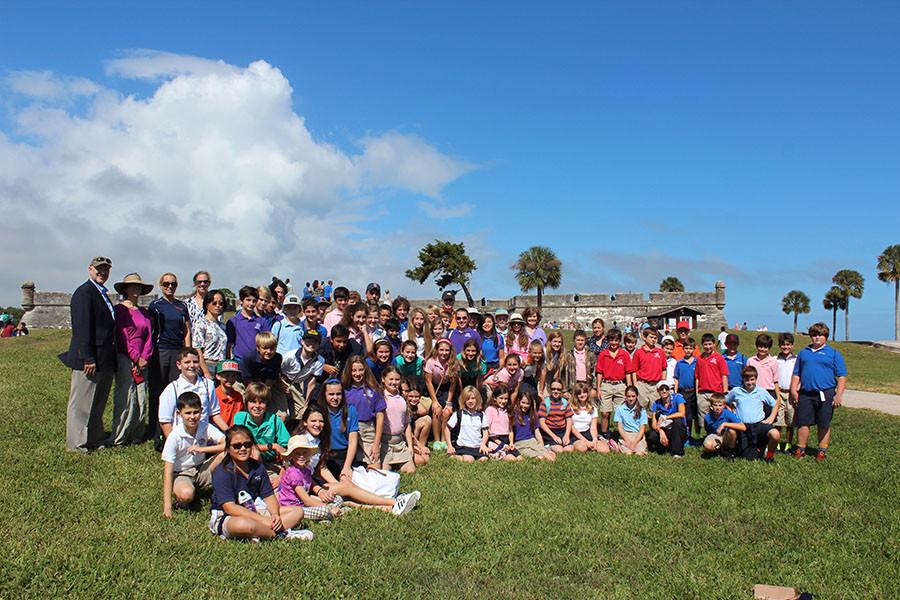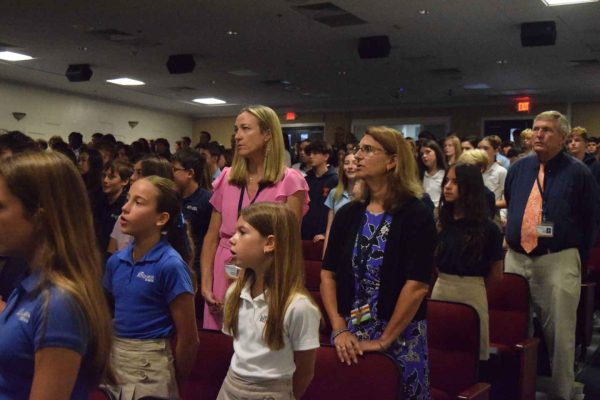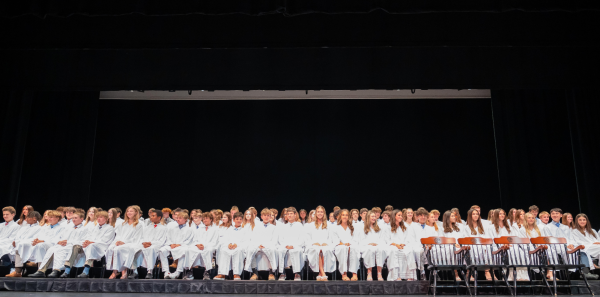Students Relive the Past in Trip to St. Augustine
The students looked up at the three men dressed in 18th-century Spanish infantry attire, their red vests and dark continental hats contrasting sharply against the blue afternoon sky. The men milled around the low wall before beginning their practiced routine: marching dutifully into place at the behest of the commanding officer who was barking out orders. At that point, some of the students below began covering their ears. They knew what was coming. Finally, the students heard “Fire!” There was a pregnant pause, and then a thunderous “boom” as a flash of fire roared above the students’ heads.
Fortunately, there was no real cannon ball that flew overhead, but a loaf of bread that was instead launched into Matanzas Bay. The firing of this live cannon was only one of several exciting events the sixth graders experienced on their October 23 St. Augustine trip.
As a result of their unit on early American colonization, the sixth graders traveled to “The Ancient City” for the day. It was the first time the sixth grade had traveled there as a group, but sixth-grade history teacher Mrs. Pamela Quigley and Head of Middle School Mr. Charles Hagy felt it would be a great opportunity for the students to have some hands-on learning.
“We decided to do this trip because we wanted the students to experience daily life in an early colonial city,” said Quigley. “[We also wanted to] reinforce European colonization and Florida’s Spanish history to create an understanding of Native Americans and the effect colonial expansion had on their lives,” she explained.
Mr. Hagy wants to make the St. Augustine journey an annual tradition because the students get to see and learn so much about early American history in just one day. “We really participated in the colonial life experience there,” said Hagy. “There is a museum we went to, and the Castillos de San Marcos fort, and we took a trolley ride tour all around the city.”
The sixth graders left for St. Augustine at 6:00 in the morning on two chartered buses and arrived at their destination around 9:30 a.m. Once there, they were met by Ms. Candy Fleming of Ancient City Tours who helped lead the tour of the city, doling out facts and information while answering any questions the students had.
The first stop was the site of the initial Spanish settlement that was led by Admiral Pedro Menéndez de Avilés in 1565. There the students saw the largest free-standing cross in the United States. Known as “The Great Cross,” it measure 208 feet tall and symbolizes the advent of Christianity in the new world and, according to its plaque, “the religious beginning of our nation.”
Next was Fountain of Youth Archaeological Park. Housed within a large wooden structure, students were able to read about the mythical Fountain of Youth, which was supposed to make young anyone who drank or bathed in its waters. In fact, guests were encouraged to drink, using the provided small cups, from the small spring flowing from the underground aquifer that is thought to be the source of Spanish explorer Juan Ponce de León’s Fountain of Youth.
The students then stayed within the park and walked to the reconstructed Timucuan village. The Timucuan were the native people who lived in the area when the Spanish arrived in 1565 and, for a while, they lived peacefully with the Spanish settlers, helping them to grow food, build shelters, and manage the climate and terrain. Thanks to a host of re-enactors playing the parts of individuals from centuries past, the students learned about the Spanish settlers and native Timucuan tribe and were even given a rifle demonstration from an 18th-century Spanish soldier.
Other highlights at the park included the the planetarium which illustrated how sailors navigated using the stars and the 30-foot high rotating Discovery Globe that depicted the routes of various explorers and how the New World was settled by the Spanish, French, and English.
The students also visited the Castillo de San Marcos National Monument, the oldest masonry fort in the Continental U.S. Construction on the fort was begun in 1672 and completed in 1695. Built mainly from strong coquina (sedimentary rock composed of layers of seashells), the outpost’s walls could withstand heavy cannon fire without breaking and it was never taken, successfully defending St. Augustine during its 238-year commission as a military fort. Despite several attacks from the British, the Castillo never fell into enemy hands, aided by its four diamond-shaped bastions which were lined with cannons, allowing the fort to defend the city from every direction, including Matanzas Bay to the east on which it was built.
The students then took a trolley tour through the city which took them through Flagler College, named for influential American businessman Henry Flagler whose involvement with Standard Oil and the Florida East Coast Railway had a huge impact on the Sunshine State in the 19th century. The sixth graders were inundated with information, but they seemed to enjoy the experience of the mobile classroom.
“It was really fun,” said sixth grader Emeline Smith, “and I loved how the guides interacted with us. I especially loved the shopping part and the planetarium. I [was] very happy to have been able to have this experience.”
According to Quigley, St. Augustine allowed the past to come to life for her students and the trip was much more effective than simply reading about early Florida in a book.
“We wanted [the students] to learn to make connections between early settlements in North America: St. Augustine, Jamestown, Plymouth, and Roanoke,” she said. “This trip was made to support the sixth grade Heritage Day and Coming to America projects that the students are doing in English, and the Center for Creative Education project in history. It bridged history and English into a humanities approach to learn about colonial America…and I am very pleased with the way this trip turned out.”
Because the trip was such a success, it may pave the way for future sixth-grade classes to make the trip to America’s “Ancient City.” Despite it being America’s oldest permanent European settlement, there’s always something new to learn in St. Augustine.
“I learned so much,” said Jacob Steinger. “I learned all about the fort and it was really cool because I have heard all about it, but have never gotten to experience it until now. It was fun to learn about how the walls were built and the way the coquina disintegrates when you touch it. This was an amazing trip.” Perhaps the first of many for the sixth grade.









